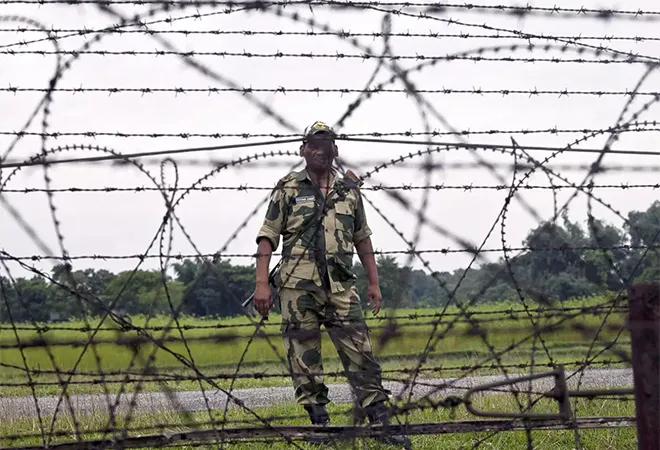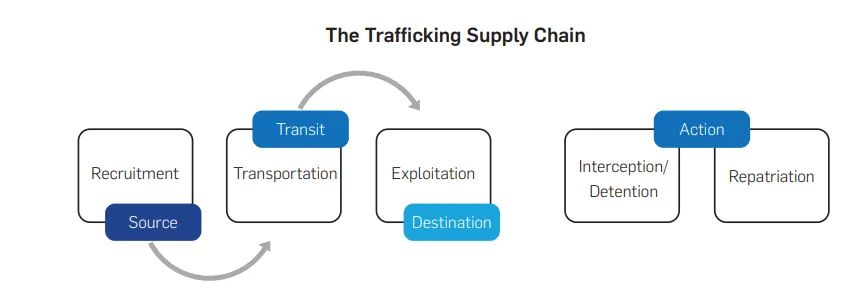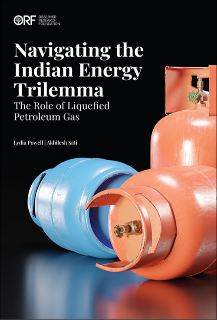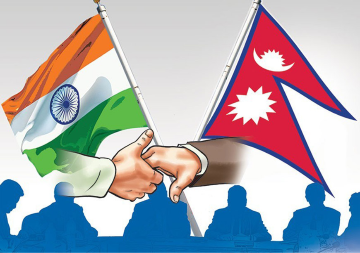
Human trafficking is a complex and rampant phenomenon that has scarred
nearly 40 million people within the South and South East Asian region. Predictably, females including children account for 71 percent of the populace who are entangled in the vicious circle of forced labour, sexual brutality, and forced matrimony.
South Asia comprises nations like India and Bangladesh that are the source, transit, and destination countries for trafficking in persons. Thousands of people mostly belonging to the underprivileged socio-economic fabric of the society are enticed to Indian capitals and towns annually by traffickers who promise decent jobs but sell them into modern-day slavery. Amongst these vulnerable people are stateless
Rohingyas who are currently surviving in the camp areas of Bangladesh without any hope for return to Myanmar which is currently embroiled in political turmoil and interminable humanitarian crisis.
Thousands of people mostly belonging to the underprivileged socio-economic fabric of the society are enticed to Indian capitals and towns annually by traffickers who promise decent jobs but sell them into modern-day slavery.
Recently, the Indian investigation team
busted a trafficking racket that exposed the displaced Rohingyas along with Bangladeshi girls/women being trafficked to different parts of India. The traffickers involved in this organised crime are associated with other accomplices who are operating from different corners of the two nations. The investigation was eventually initiated as six Rohingyas were detained last year for travelling without any legal credentials. Upon probing this even further, the existing trafficking networks have come to light, and while some traffickers associated with them are arrested, other names are yet to surface. In another incidence,
26 displaced Rohingyas have been captured at the end of May 2022, including 12 minors and eight women who were seeking to travel ultimately to Bangladesh from the refugee camps in Jammu. They are currently placed in a detention centre in Silchar, Assam.
 Source: UNODC 2018
Source: UNODC 2018
It is easy for the preparators to prey on these individuals since they lack basic rights due to the lack of citizenship, and a legitimate and steady source of income except for the humanitarian aid received from the donors. The deplorable conditions within the camp areas with inadequate WASH facilities, food insecurity, improper healthcare, and livelihood opportunities force them to look outside for better opportunities. But once caught they are put into prison without any assurance of their release since they do not fall under the jurisdiction or protection of any nation. These incidences bring to the fore the vulnerability and dilemma of such stateless people.
Transparent borders
Trafficking between India and Bangladesh border areas is quite pronounced and simple. Both nations share the fifth longest international border in the world,
nearly 4,096.7 km long. Around 60 percent of the border is fenced and a large section of the border runs through rivers, fishponds, farming lands, villages, and even houses where a portion of it lies in India while another portion of the same house or property is situated in Bangladesh. Thus, guarding the border zones is not simple due to improper roads and difficult terrains. Consequently, it becomes easier for illegal groups to misappropriate these porous stretches.
According to a study, almost half of the trafficking from Bangladesh to India takes place through Benapole in the Jessore district of Bangladesh. The major points like Thanurbairi Chandurila, Kaiba Sultanpur, Chodarpur, Chapainaababguj, Hill Akhwara, Chuadanga and Poladanga are other entry points for trafficking in India.
In the current reports, it has been mentioned that apart from selling women or girls in the commercial sex business or forced labour, they are also being coerced into the IVF business.
In 2020, the number of women caught on the International Border between India and Bangladesh was 915 till August. In
2019, the number was 936, 1,107 in 2018, and 572 in 2017. As per a study conducted by Anti-human trafficking NGO Justice and Care, in association with Border Security Force (BSF), more than 5 Lacs Bangladeshi women and children aged between 12 and 30 have been illegally sent to India in the last decade. However, underreporting in such cases is a major hurdle. Family honour, shame, and fear play a significant role in preventing a person from coming forward and sharing their traumatic experiences.
As per the police reports, there is a growing network of traffickers who are either women or are using different women to trap their victims. Rohingya women are either abducted or recruited under false job promises or married off and sold. The traffickers organise forged documents for the entry of the victims. In the current reports, it has been mentioned that apart from selling women or girls in the commercial sex business or forced labour, they are also being coerced into the IVF business.
However, being stateless adds to the dilemma since they do not receive any protection once caught and remain in prison or shelter homes awaiting proper solutions to come through.
Present legal mechanisms
To curb this crime, there are several Anti-Trafficking laws in both nations. In India,
Article 23(1) of the Constitution,
IPC 366 - 373, the
Immoral Traffic (Prevention) Act 1956, and provisions under other laws relating to the protection of women and children. The Draft
Trafficking in Persons (Prevention, Care and Rehabilitation) bill is still underway that hopes to provide holistic preventive measures on trafficking. Similarly in Bangladesh, the Prevention and Suppression of Human Trafficking Act, 2012, the
Repression of Women and Children Act of 2000 (amended in 2003), and Articles 372 and 373 of its penal code prohibit and punish child traffickers.
The Draft Trafficking in Persons (Prevention, Care and Rehabilitation) bill is still underway that hopes to provide holistic preventive measures on trafficking.
While both countries have legislative, constitutional, and other forms of legal interventions to address the issues of trafficking, the implementation of these interventions requires equally strenuous efforts. It demands a more efficient and smoother level of cooperation between the various stakeholders involved and offices of authority to ensure the implementation of the protection of the possible victims of such trafficking and the prosecution of the offenders that initiate and propagate the crimes.
The
MoU signed between New Delhi and Dhaka in 2015 has been a comprehensive approach that seeks to fortify collaboration to thwart all forms of human trafficking, especially trafficking of women and children, their rescue, and recovery. It safeguards the provision for prompt investigation and prosecution of traffickers and organised crime syndicates in either country, including the repatriation of victims. However, the growing number of cases shows the fault lines within the system that needs to be addressed.
Challenges
A major point that comes into focus is the
low rate of conviction and the number of prosecutions and investigations as compared to the scale and extent of trafficking within both nations. Officials involved in handling and preventing trafficking have, in many cases been found complicit with the offenders. In addition, there has been a persistent lapse on the government’s end in reporting and investigating such cases and allegations. Another point for low conviction or dismissal of cases is the lack of witnesses. It has been noted that victims and witnesses have to pay for their travel whenever they are required, and they are not compensated for the same or provided any protection.
Regrettably, despite
Rohingyas being allowed by Law to file cases of trafficking, the judiciary machinery disregards these attempts. Consequently, traffickers and offenders in the country find it easy to get away with their activities right under the watch of the officials, owing to such loopholes and gaps in implementation.
Since both India and Bangladesh are not party to the 1951 Refugee Convention or its 1967 Protocol, they do not consider the Rohingyas as a refugee but both nations are signatory to several core treaties which requires states to ensure access to basic human rights and human dignity for all and provide basic protection to people seeking asylum. Thus, proper legal channels are essential for this community. Clear legal mechanisms need to be set up within the camp areas that will help give a voice to these people, access justice, and punish preparators.
In addition to this, some of the factors that need to be addressed to make the overall situation conducive are first, a need for capacity building whereby training of border security agencies and law enforcement agencies from both sides for raising awareness on victim identification, agency referrals, and repatriation procedures will benefit effective border management.
Despite Rohingyas being allowed by Law to file cases of trafficking, the judiciary machinery disregards these attempts. Consequently, traffickers and offenders in the country find it easy to get away with their activities right under the watch of the officials, owing to such loopholes and gaps in implementation.
Second, the regularity of meetings of the Joint Task Force on India and Bangladesh needs to be improved and increased. This will also help in the dissemination of correct information, protocol adherence, and quick action.
Third, funding is necessary for the smooth functioning of the programs and digitization of the process.
Fourth, the identification of government employees enmeshed in this trafficking cycle is essential. Designing mechanisms to address corruption like flagging unlawful financial deals will be critical to an effective response.
Fifth, victim care is of supreme importance. There is a need to treat the victims with respect and provide proper medical facilities, and protection.
Lastly, an integrated SOP between both nations addressing the above issues will be of effectiveness to bring about the desired result. Currently, an SOP is underway but it needs to be presented and ratified soon.
Thus, it becomes imperative that both India and Bangladesh urgently address the prevailing gaps in cross-border management by formulating integrated SOPs that facilitate each point to restrict crime.
The views expressed above belong to the author(s). ORF research and analyses now available on Telegram! Click here to access our curated content — blogs, longforms and interviews.



 Human trafficking is a complex and rampant phenomenon that has scarred
Human trafficking is a complex and rampant phenomenon that has scarred 
 PREV
PREV


